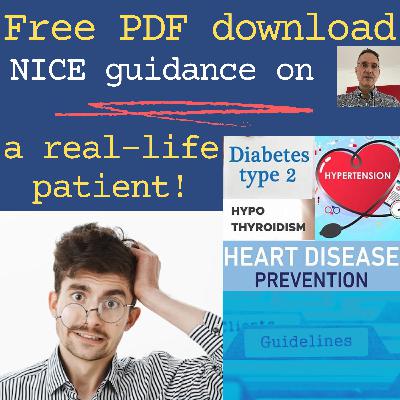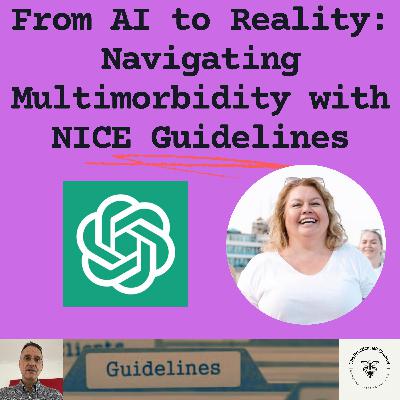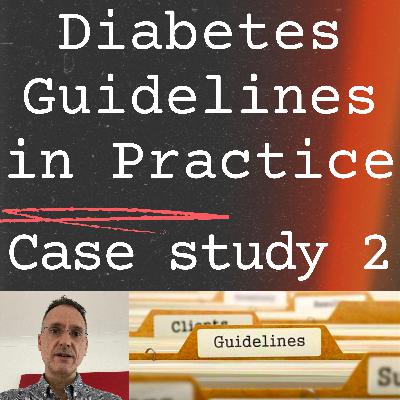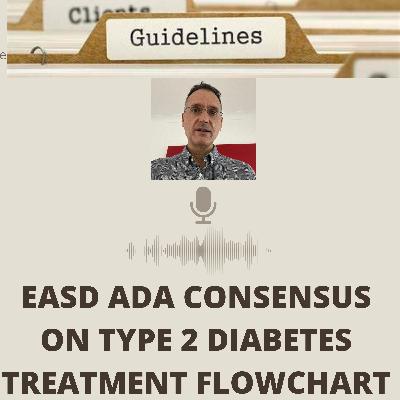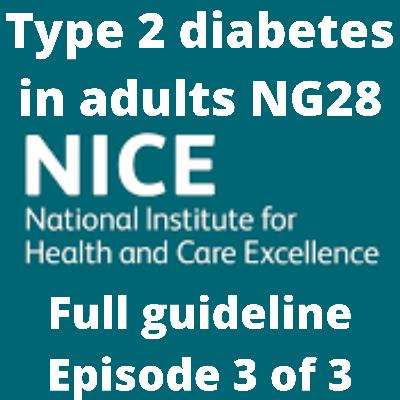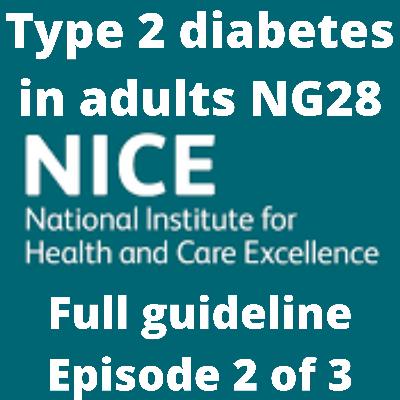Real life complex patient: NICE on diabetes, hypertension, hypertriglyceridemia and hypothyroidism
Description
My name is Fernando Florido and I am a GP in the United Kingdom. In today’s episode I look at a real-life case to demonstrate how the guidelines could apply to it. By way of disclaimer, I am not giving medical advice; this video is intended for health care professionals and you must use your clinical judgement.
The PDF version of this episode can be found here:
· Colour version: https://1drv.ms/b/s!AiVFJ_Uoigq0l3MBwm5sUpEybW8r?e=xio6pz
· Printer friendly version: https://1drv.ms/b/s!AiVFJ_Uoigq0l3RhABLRM2_pQQOz?e=jzuMxb
There is a YouTube version of this and other videos that you can access here:
· The NICE GP YouTube Channel: NICE GP - YouTube
Prescribing information links:
· Website: https://cks.nice.org.uk/topics/diabetes-type-2/prescribing-information/dpp-4-inhibitors/
· Download PDF: https://1drv.ms/b/s!AiVFJ_Uoigq0liBvuQq8_0Cd-GSz?e=NnL56J
· Website: https://cks.nice.org.uk/topics/diabetes-type-2/prescribing-information/glp-1-receptor-agonists/
· Download PDF: https://1drv.ms/b/s!AiVFJ_Uoigq0liFRycIZPaVfj-lC?e=a2QTNY
Intro / outro music: Track: Halfway Through — Broke In Summer [Audio Library Release]
Music provided by Audio Library Plus
Watch: https://youtu.be/aBGk6aJM3IU
Free Download / Stream: https://alplus.io/halfway-through
Transcript
Hello everyone and welcome. My name is Fernando and I am a GP in the United Kingdom.
We have looked at fictitious patients in previous episodes but, in today’s episode, I am going to look at a real diabetic case to see how the guidelines could apply to it. And as you know, we are focusing only on the pharmacological treatment. If you want to download a PDF version of this episode, the link is in the episode description.
Please note that I am not giving medical advice; this is only my interpretation of the guidelines and you must use your clinical judgement
Remember that there is also a Youtube version of these episodes so have a look in the episode description.
Right, so let’s get straight into it. The details, which have been anonymised, belong to a real patient, so we have 46-year-old man of Asian descent with T2DM who presents with the following:
- HbA1c is 68 mmols/mol/8.4% (therefore poorly controlled)
- Cholesterol 5.9
- Triglycerides 5.72
- HDL 0.97
· The path lab has not calculated LDL because triglycerides >4.5
· Liver and Renal function tests are normal with an eGFR of 97
- Thyroid function tests show a borderline low T4 of 9 (NR 9-19.1) and a raised TSH of 9.88 (NR 0.35-4.94
- ACR normal
- FBC and other routine blood tests were normal.
- His BMI is 32, so he is obese
- His BP is 147/89
- His PMH includes:
- Hypothyroidism
- T2DM
- His regular treatment is with:
- Levothyroxine 200mcg daily
- Metformin 500 mg TDS
He comes to discuss his test results, feeling well in himself. His obesity is long-standing and being managed with diet and lifestyle advice. He has had hypothyroidism for 15 years and, on prompting, he says that he is feeling a little tired
So, let’s have a look at the guidelines. As usual I will focus on the NICE guidelines and we will have to looks at the guidelines on type 2 diabetes, hypertension, prevention of cardiovascular disease, and hypothyroidism
Let’s look at his diabetes first.
Firstly, NICE says that we need to consider if rescue therapy is necessary for symptomatic hyperglycaemia with insulin or a sulfonylurea. However, he is well and asymptomatic so we do not have to do this.
We see that his current dose of metformin 500 mg 3 times a day is not enough to control his diabetes. So, given that his renal function is completely normal. we should increase the dose to the maximum of 2000mg daily, that is, 1000mg twice a day. However, this is unlikely to be enough to bring his HbA1c of 68 or 8.4% to target. And let’s remember that according to NICE we should strive for the following targets:
· Lifestyle management only— 48 mmol/mol (6.5%).
· A single drug not associated with hypoglycaemia (such as metformin) — 48 mmol/mol (6.5%).
· Drug treatment associated with hypoglycaemia (such as a sulfonylurea): 53 mmol/mol (7.0%).
· Always adjust for people who are frail, elderly or with other co-morbidities
This patient is young and otherwise well so we should aim to treat him aggressively.
NICE says that for people not controlled on metformin alone, we should consider dual therapy but which?
We need to assess the person's cardiovascular status and risk to determine whether they have chronic heart failure, established atherosclerotic cardiovascular disease, or are at high risk of developing cardiovascular disease.
This patient does not have heart failure or cardiovascular disease but using an online calculator, his 10-year QRISK3 score is 12%. So, being over 10%, we will consider him at high risk of developing CVD.
And NICE says that if the patient is at high risk of developing cardiovascular disease, we will consider an SGLT-2 inhibitor with proven cardiovascular benefit in addition to metformin.
This is good because it seems quite clear that his obesity is a problem and both metformin and SGLT2 inhibitors promote weight loss.
Because we would want to manage him aggressively, I would advise him to increase metformin straightaway and as soon as we know that it is tolerated, which could be a matter of days, we could start the SGLT2 inhibitor.
SGLT2 inhibitors with proven cardiovascular benefit includes dapagliflozin, empagliflozin and canagliflozin
Remember that SGLT2 inhibitors are associated with an increased risk of DKA and lower limb amputation. Therefore, before starting an SGLT2 inhibitor, we need to check whether the person may be at increased risk of diabetic ketoacidosis (DKA), for example if:
- they have had a previous episode of DKA
- they are unwell with intercurrent illness
- Or they are following a very low carbohydrate or ketogenic diet, and if so, not to start the SGLT2 inhibitor until they have changed their diet. We will also advise them not to start this type of diet while they are on this medication.
- The increased risk of lower-limb amputation has been shown with Canagliflozin but there is some concern that the risk may be a class effect. We will need to ensure that foot care is optimised before starting the SGLT2 inhibitor.
- So, this would be my pharmacological action from a diabetic perspective. Increase metformin to 1000mg BD and start an SLGT2 inhibitor, for example, dapagliflozin 10 mg OD.
- Now let’s have a look at his BP, which is elevated at 147/89.
- NICE says that people under the age of 80 should have a BP below 140/90.
- To confirm the diagnosis, we should arrange ambulatory or home blood pressure monitoring and if the average is greater than 135/85 we will start him on antihypertensive treatment. We have more or less established that he does not have end-organ damage because of his normal renal function, normal urinary albumin / creatinine ratio and, looking at his records, normal fundoscopy, as he attends for his annual diabetic retinal screening programme. To be strict, we should also arrange an ECG to ensure that there are no signs of left ventricular hypertrophy.
- Let’s assume that his BP is indeed above the target. What treatment should we start? </s

